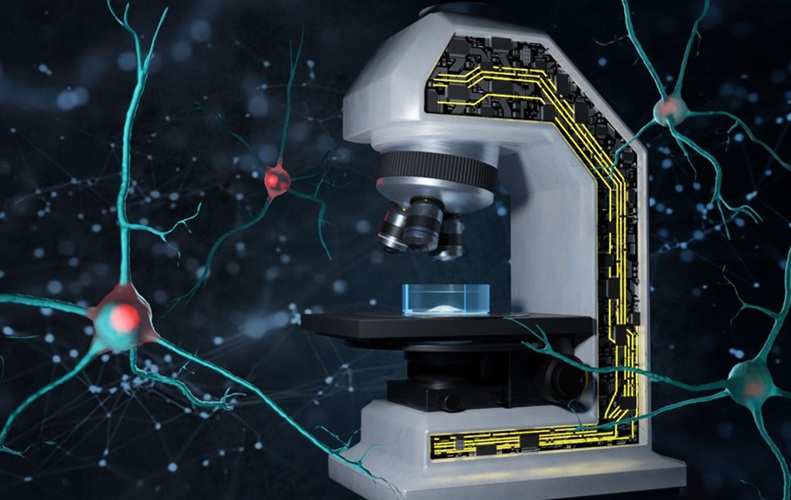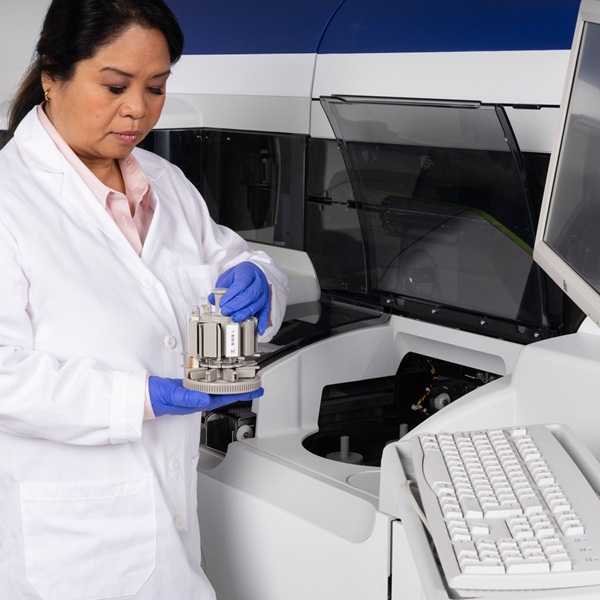Critical Gene Altered in Numerous Fibroadenoma Patients
|
By LabMedica International staff writers Posted on 13 Aug 2014 |

Image: Histopathological image of breast fibroadenoma from a core needle biopsy (Photo courtesy of Dr. Jeremy Thomas).
Advanced DNA sequencing technologies have been used to identify a critical gene that was repeatedly disrupted in nearly 60% of fibroadenoma cases.
Frequently discovered in clinical workups for breast cancer diagnosis and during routine breast cancer screening, clinicians often face the challenge of distinguishing fibroadenomas from breast cancer.
A multidisciplinary team of scientists from the National Cancer Center Singapore (Singapore) and their colleagues studies a total of 98 fibroadenoma tumors of which 12 were from fresh-frozen tumors and a further 86 were from archival formalin-fixed paraffin-embedded (FFPE) samples. Tumors and whole blood were obtained from patients undergoing surgical excision of fibroadenoma.
The team used a variety of molecular techniques including a technique called laser capture microdissection (LCM). Fresh-frozen fibroadenomas were embedded in optimal cutting temperature (OCT) compound and 8 μm-thick sections were cut using a microtome cryostat. Stained slides were then loaded onto the laser capture microscope stage. The ArcturusXT Laser Capture Microdissection (LCM) System and a Capsure Macro LCM cap (Life Technologies, Grand Island, NY, USA) were then placed automatically over the chosen area of the tissue.
By analyzing all the protein-coding genes in a panel of fibroadenomas from the patients, the team identified frequent mutations in a gene called Mediator Complex Subunit 12 (MED12) in a remarkable 60% of fibroadenomas. Like most breast tumors including breast cancers, fibroadenomas consist of a mixed population of different cell types, called epithelial cells and stromal cells. However, unlike breast cancers where the genetic abnormalities arise from the epithelial cells, the scientists showed that the pivotal MED12 mutations in fibroadenomas are found in the stromal cells using the LCM technique.
Patrick Tan, MD, PhD, a professor and a lead author of the study said, “It is amazing that these common breast tumors can be caused by such a precise disruption in a single gene. Our findings show that even common diseases can have a very exact genetic basis. Importantly, now that we know the cause of fibroadenoma, this study can have many potential applications. For example, measuring the MED12 gene in breast lumps may help clinicians to distinguish fibroadenomas from other types of breast cancer. Drugs targeting the MED12 pathway may also be useful in patients with multiple and recurrent fibroadenomas as this could help patients avoid surgery and relieve anxiety.” The study was published on July 20, 2014, in the journal Nature Genetics.
Related Links:
National Cancer Center Singapore
Life Technologies, Grand Island
Frequently discovered in clinical workups for breast cancer diagnosis and during routine breast cancer screening, clinicians often face the challenge of distinguishing fibroadenomas from breast cancer.
A multidisciplinary team of scientists from the National Cancer Center Singapore (Singapore) and their colleagues studies a total of 98 fibroadenoma tumors of which 12 were from fresh-frozen tumors and a further 86 were from archival formalin-fixed paraffin-embedded (FFPE) samples. Tumors and whole blood were obtained from patients undergoing surgical excision of fibroadenoma.
The team used a variety of molecular techniques including a technique called laser capture microdissection (LCM). Fresh-frozen fibroadenomas were embedded in optimal cutting temperature (OCT) compound and 8 μm-thick sections were cut using a microtome cryostat. Stained slides were then loaded onto the laser capture microscope stage. The ArcturusXT Laser Capture Microdissection (LCM) System and a Capsure Macro LCM cap (Life Technologies, Grand Island, NY, USA) were then placed automatically over the chosen area of the tissue.
By analyzing all the protein-coding genes in a panel of fibroadenomas from the patients, the team identified frequent mutations in a gene called Mediator Complex Subunit 12 (MED12) in a remarkable 60% of fibroadenomas. Like most breast tumors including breast cancers, fibroadenomas consist of a mixed population of different cell types, called epithelial cells and stromal cells. However, unlike breast cancers where the genetic abnormalities arise from the epithelial cells, the scientists showed that the pivotal MED12 mutations in fibroadenomas are found in the stromal cells using the LCM technique.
Patrick Tan, MD, PhD, a professor and a lead author of the study said, “It is amazing that these common breast tumors can be caused by such a precise disruption in a single gene. Our findings show that even common diseases can have a very exact genetic basis. Importantly, now that we know the cause of fibroadenoma, this study can have many potential applications. For example, measuring the MED12 gene in breast lumps may help clinicians to distinguish fibroadenomas from other types of breast cancer. Drugs targeting the MED12 pathway may also be useful in patients with multiple and recurrent fibroadenomas as this could help patients avoid surgery and relieve anxiety.” The study was published on July 20, 2014, in the journal Nature Genetics.
Related Links:
National Cancer Center Singapore
Life Technologies, Grand Island
Latest Molecular Diagnostics News
- AI-Powered Cytology Tool Detects Early Signs of Oral Cancer
- Non-Invasive Liquid-Based Cytology Test Enables Early Endometrial Cancer Detection
- Bioluminescent Molecular Diagnostics Platform Enables Rapid On-Site Pathogen Detection
- Comprehensive Genomic Testing Reveals Treatment Targets In 90% Of Advanced Solid Tumors
- Blood Tests Show Potential for Colorectal Cancer Detection
- New Nanotechnology Efficiently Unzips DNA for Quick and Easy Genetic Testing
- Rapid Point-of-Care COVID-19 Test Delivers Digital Results in 15 Minutes
- First Blood-Based Test Measures Key Alzheimer's Biomarker in Asymptomatic and Symptomatic Individuals
- Rapid Molecular Diagnostic Device to Detect and Differentiate Ebola and Marburg Virus Species
- New RNA-Based Measure Predicts Mortality Risk and Tracks Aging
- Simultaneous DNA Testing and RNA Fusion Testing Improves Diagnosis of NUT Carcinoma
- Genetic Biomarker Test Could Guide Brain Cancer Treatment
- Rapid HSV-2 Test Sets New Standard in STI Diagnostics
- Novel Diagnostic Tool to Revolutionize Treatment Guidance of Head and Neck Cancer
- Gene Signature Could Serve as Early Warning System for Aggressive Pancreatic Cancer
- Fast Triple Test a Game Changer for Expectant Mothers
Channels
Clinical Chemistry
view channel
Paper Strip Saliva Test Detects Elevated Uric Acid Levels Without Blood Draws
Diagnosing elevated uric acid (UA) levels—an important indicator for conditions like gout, chronic kidney disease, and metabolic syndrome—typically requires blood draws, lab equipment, trained technicians,... Read more
Prostate Cancer Markers Based on Chemical Make-Up of Calcifications to Speed Up Detection
Prostate cancer can be difficult to detect early, limiting timely and appropriate treatment. While calcification—calcium build-up in soft tissues—has previously been suggested as a possible indicator,... Read moreHematology
view channel
Portable and Disposable Device Obtains Platelet-Rich Plasma Without Complex Equipment
Platelet-rich plasma (PRP) plays a crucial role in regenerative medicine due to its ability to accelerate healing and repair tissue. However, obtaining PRP traditionally requires expensive centrifugation... Read more
Disposable Cartridge-Based Test Delivers Rapid and Accurate CBC Results
Complete Blood Count (CBC) is one of the most commonly ordered lab tests, crucial for diagnosing diseases, monitoring therapies, and conducting routine health screenings. However, more than 90% of physician... Read moreImmunology
view channel
Precision Tool Predicts Immunotherapy Treatment Failure in Melanoma Patients
Melanoma, though accounting for only about 4% of skin tumors, is the deadliest form of skin cancer due to its high potential to metastasize. While immunotherapy, especially PD-1 protein blockade, has revolutionized... Read more
Paper-Based Device Accurately Detects Immune Defects in 10 Minutes
Patients with hidden immune defects are especially vulnerable to severe and persistent infections, often due to autoantibodies that block interferon-gamma (IFN-γ), a key molecule in immune defense.... Read more
New AI System Uncovers Hidden Cell Subtypes to Advance Cancer Immunotherapy
To produce effective targeted therapies for cancer, scientists need to isolate the genetic and phenotypic characteristics of cancer cells, both within and across different tumors. These differences significantly... Read more
Evolutionary Clinical Trial to Identify Novel Biomarker-Driven Therapies for Metastatic Breast Cancer
Metastatic breast cancer, which occurs when cancer spreads from the breast to other parts of the body, is one of the most difficult cancers to treat. Nearly 90% of patients with metastatic cancer will... Read moreMicrobiology
view channel
Saliva Test Detects Implant-Related Microbial Risks
Infection is the most frequent and preventable cause of dental implant failure, with microbial organisms contributing to inflammation, tissue degradation, and systemic immune response—often without visible... Read more
New Platform Leverages AI and Quantum Computing to Predict Salmonella Antimicrobial Resistance
Antimicrobial-resistant Salmonella strains are a growing public health concern due to the overuse of antimicrobials and the rise of genetic mutations. Accurate prediction of resistance is crucial for effective... Read more
Early Detection of Gut Microbiota Metabolite Linked to Atherosclerosis Could Revolutionize Diagnosis
Cardiovascular disease is the leading cause of death worldwide, and atherosclerosis plays a critical role in its development. This chronic condition, characterized by the hardening and narrowing of arteries... Read morePathology
view channel
Novel Method To Analyze Tumor Growth Rates Helps Tracks Progression Between Diagnosis and Surgery
Patients diagnosed with breast cancer often worry about how quickly their tumors grow while they wait for surgery, and whether delays in treatment might allow the disease to spread beyond the point of cure.... Read more
Novel Technology Detects Key Mutations from Blood Samples in Metastatic Colorectal Cancer Patients
Accurate and timely mutation profiling in patients with metastatic colorectal cancer is critical for effective treatment monitoring and relapse detection. However, conventional approaches often rely on... Read more
Self-Driving Microscope Tracks and Analyzes Misfolded Protein Aggregation in Real Time
The accumulation of misfolded proteins in the brain is central to the progression of neurodegenerative diseases like Huntington’s, Alzheimer’s, and Parkinson’s. Yet to the human eye, proteins that are... Read moreTechnology
view channel
New Microfluidic System Enables Early Cancer Diagnosis Using Simple Blood Tests
Circulating tumor cells (CTCs), which break off from primary tumors and travel through the bloodstream, pose a significant risk by forming secondary tumors in other organs. Detecting and analyzing these... Read more
AI to Transform Skin Cancer Diagnosis in Remote Areas
Many patients living in remote regions lack timely access to dermatological care, often facing long wait times and delayed diagnoses for potentially serious conditions like skin cancer. Healthcare backlogs... Read moreIndustry
view channel
IFCC WorldLab 2026 To Be Held in India on October 25-29
The International Federation of Clinical Chemistry and Laboratory Medicine (IFCC, Milan, Italy) will hold its 27th International Congress of Clinical Chemistry and Laboratory Medicine (IFCC WorldLab 2026)... Read more




















